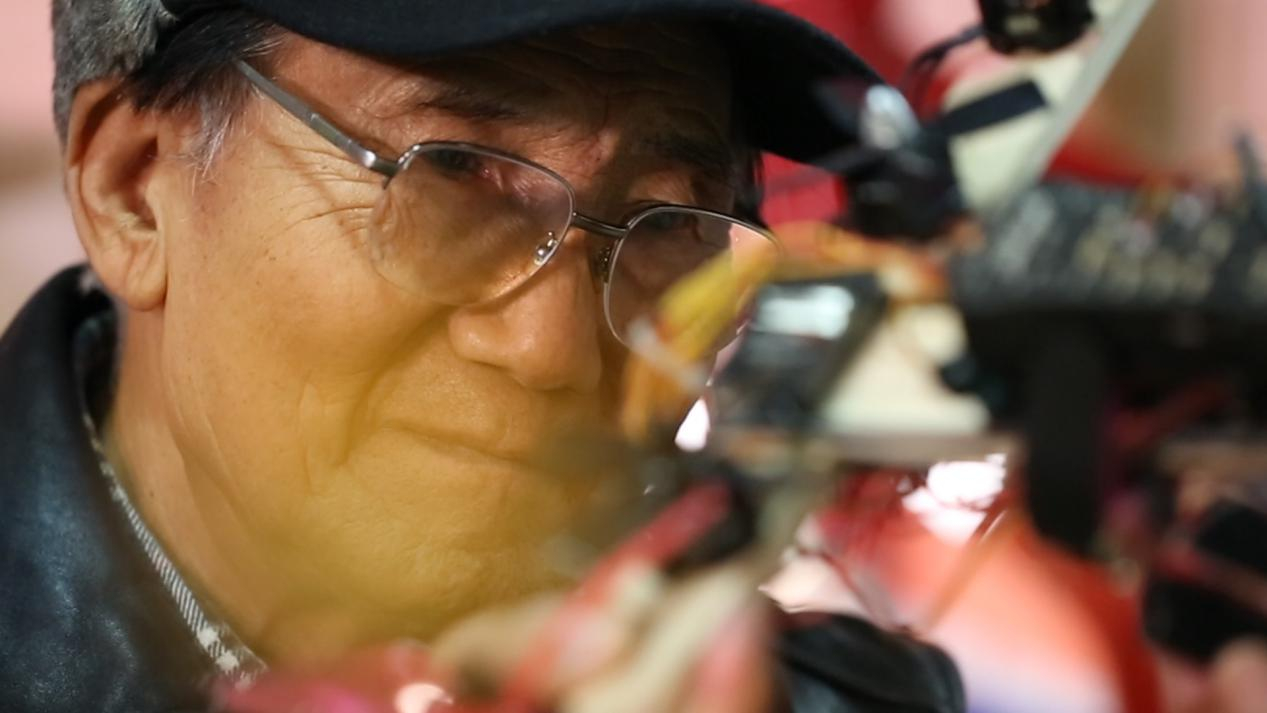
Tech & Sci
14:07, 28-Dec-2018
TECH IT OUT: FPV, the future racing
Updated
13:36, 31-Dec-2018
By Yang Zhao, Ruan Xiaoxuan, Chen Huidong
05:17

First-person-view (FPV) drone racing, the art of flying drones around obstacle courses at incredible speeds (180 to 200 Kilometers per hour) and using head-mounted displays and joysticks to control their direction, has started to emerge as a new sport in China.
Since the first race began in China, FPV has attracted a loyal fan base, among them are a number of professional pilots who intend to turn this novelty concept into a mainstream sport.

Google provides first-person-view for drone pilots. /CGTN Photo
Google provides first-person-view for drone pilots. /CGTN Photo
Hou Guancheng, a video game programmer, is one of the drone racing enthusiasts. "It's like F1 for drones, racing in the sky. It's like what you watched in the Star Wars movies," said Hou. It is clear he still remembers in his mind the thrill of when he first played a real-life version of a racing video game,
"I started to learn about FPV around early 2015. I saw some video footage recorded by foreigners on the Internet Right away, it felt awesome."
Zhang Zinan is the founder of TCKFPV club in China. He came to know Hou Guancheng from online chat forums in 2015 when there was nowhere to buy a finished drone.

Zhang Zinan (left) and Hou Guancheng (right) are discussing racing agendas. /CGTN Photo
Zhang Zinan (left) and Hou Guancheng (right) are discussing racing agendas. /CGTN Photo
The assembly and tuning of components, which can only be removed from other devices, requires a lot of professional backgrounds. This made the model plane pilots the first drone flyers.
After years of being individual pilots, Hou and Zhang have grown into reputable competition organizers in Beijing.

An indoor race called tiny whoop designed and organized by Hou Guancheng and Zhang Zinan. /CGTN Photo
An indoor race called tiny whoop designed and organized by Hou Guancheng and Zhang Zinan. /CGTN Photo
The group of pioneers of China's FPV community also includes some senior professionals.
Sun Jingqiao is an 80-year-old expert who started to study aviation design in Beijing-based Beihang University in 1956. He is a superstar in fixed wing and helicopter sports.
"We set a world record between 1961 and 62 by breaking the Soviets' flight record of 20 kilometers. We flew 91 km, all the way to Tianjin." said Sun, who was among the first in China to study quadcopter.

Sun Jingqiao, 81, retired model plane instructor from Beihang University, Beijing, China. /CGTN Photo
Sun Jingqiao, 81, retired model plane instructor from Beihang University, Beijing, China. /CGTN Photo
And he's sticking to what he learned during his professional career, “How come a quadcopter pilot still needs training on fixed-wings? It's all about aerodynamics. You need to know how to fly, and have quick reflexes. So they're here to experience fix-wings.”

Sun Jingqiao and his team set world record of model helicopter flight distance in 1960. In the interview, he recalled the year was 1961. /CGTN Photo
Sun Jingqiao and his team set world record of model helicopter flight distance in 1960. In the interview, he recalled the year was 1961. /CGTN Photo
Since its inception in the U.S., FPV has been not only about racing but also about a mix of street culture and adventures.
"It's much like skateboarding, I am always comparing the FPV culture to skateboarding." said Andrew Camden, the American FPV icon who is now spending more of his time in China.
"There's a personality and there's a vibe that you get from skateboarding. And FPV is starting to have its own."

American FPV icon Andrew Camden, AKA Le Drib, joins the race in China. /CGTN Photo
American FPV icon Andrew Camden, AKA Le Drib, joins the race in China. /CGTN Photo
A way of expressing this spirit is to fly to those places that a pilot may deem challenging but meanwhile, feel they need to try it.
"We can race in the Hutongs. We can race in IKEA. We can race in the Shougang steel plants. Or even in amusement parks in Beijing," said Hou Guangcheng.
One of the reasons for drone's popularity in China, as Andrew Camden explains, is that China is the global leader in drone manufacturing.
"All manufacturing and innovation has to do a lot with China. Most of the components are made by my company, we have manufacturing partners in China. So this is kind of a hub of products," said Andrew.

Zhang Zinan in his studio. /CGTN Photo
Zhang Zinan in his studio. /CGTN Photo
Although the sport emerged in the U.S. and China at almost the same time, around 2015, the American market is much more mature than China's today.
Zhang thinks venture capitalists abroad can see the future and potential of this sport. But Chinese investors failed to realize the potential of this market because they never treated FPV as a real sport. It's thus very hard to develop FPV drones in China. And the sport in China will be at least one or two years behind that of other countries.
The sport has seen growth in recent years, but only the future can tell if drone racing will really soar to new heights in China.

SITEMAP
Copyright © 2018 CGTN. Beijing ICP prepared NO.16065310-3
Copyright © 2018 CGTN. Beijing ICP prepared NO.16065310-3